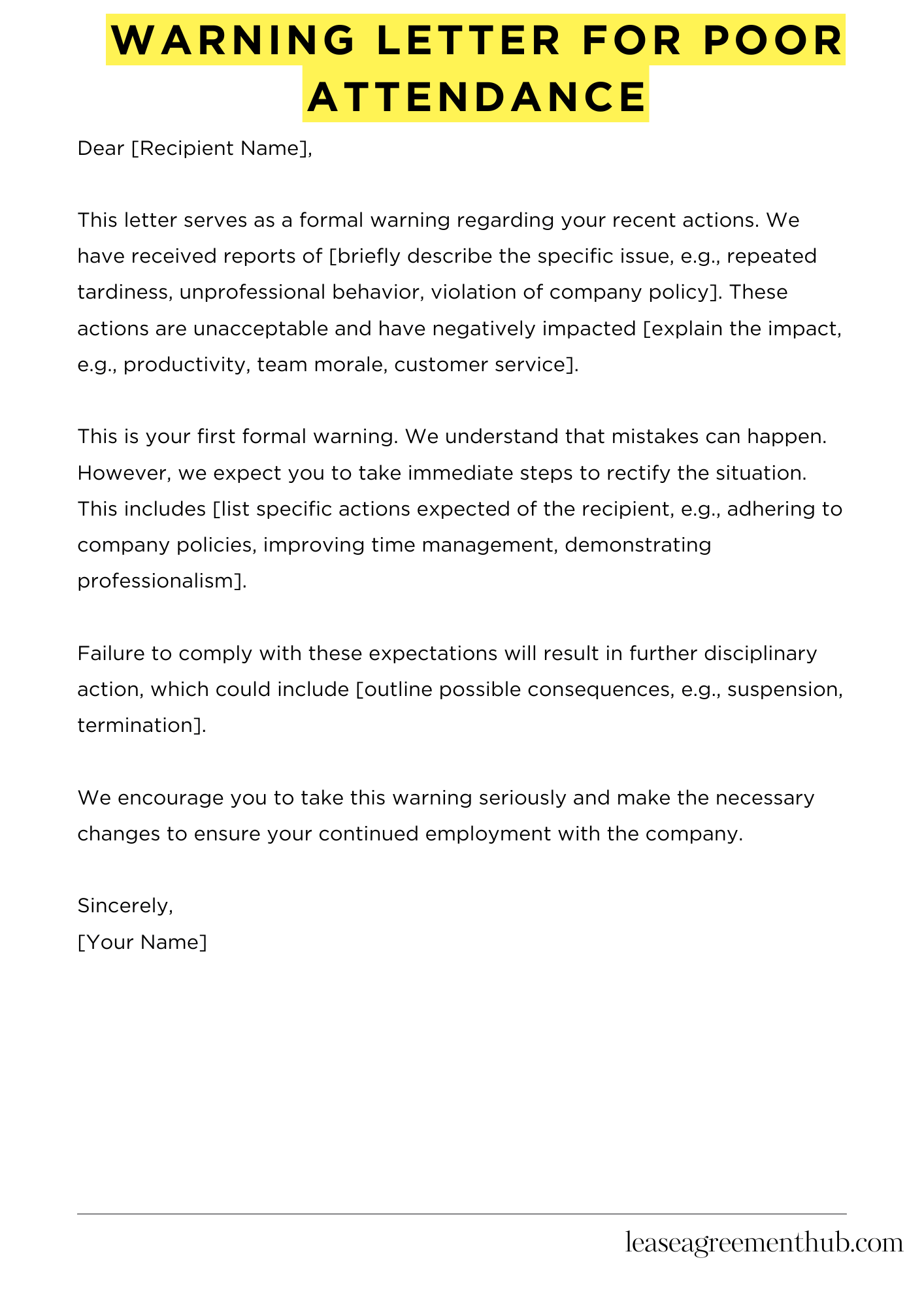A warning letter for poor attendance is a formal notice given to an employee who frequently misses work. Its purpose is to address the issue and encourage improvement. This letter serves as a record of the attendance problem and outlines the consequences if it continues.
In this article, we will provide various templates and examples of warning letters for poor attendance. These samples are designed to help you create your own letters quickly and easily. Whether you are a manager or an HR professional, these resources will make the writing process smoother.
By using our templates, you can ensure that your message is clear and effective. Each sample is crafted to address attendance issues while maintaining professionalism. This will help you communicate your concerns while giving the employee a chance to improve.
Warning Letter For Poor Attendance
[Your Name]
[Your Address]
[Your Phone Number]
[Your Email Address]
[Date]
[Employee Name]
[Employee Address]
Dear [Employee Name],
This letter is to formally warn you about your recent attendance record. We have noticed a pattern of absences and lateness that is causing concern.
Your attendance is vital to the smooth operation of our team. When you are absent, it impacts the work of your colleagues and can lead to delays in meeting deadlines.
We understand that sometimes unforeseen circumstances can cause absences. However, your recent absences have been frequent and have not been adequately explained.
This letter is not intended to be a disciplinary action. It is a warning to inform you that continued poor attendance will result in further disciplinary action, including potential termination of employment.
We encourage you to take steps to improve your attendance. If there are any personal or medical reasons that are impacting your ability to attend work, please speak to your manager so that we can explore potential solutions together.
We value your contribution to the team and hope that you will take this warning seriously and make the necessary changes to improve your attendance record.
Sincerely,
[Your Name]

How to Write a Warning Letter for Poor Attendance
Poor attendance is a serious issue in any workplace. It can disrupt workflow, impact team morale, and even lead to missed deadlines. If an employee’s attendance is consistently below par, a warning letter may be necessary. This document serves as a formal record of the issue and outlines the consequences of continued poor attendance. Writing a warning letter can be tricky, but it’s important to get it right. Here’s a guide on how to write a warning letter for poor attendance.
1. State the Purpose Clearly
The first paragraph of your warning letter should clearly state its purpose. Let the employee know that the letter is regarding their attendance and that it is a formal warning. Be direct and professional, but avoid being accusatory. You want to focus on the facts, not on assigning blame. For example, you could write something like, “This letter is to formally address your recent attendance issues. Your attendance record has fallen below the company’s acceptable standards.”
2. Provide Specific Examples
Vague statements about poor attendance won’t be helpful. Instead, provide specific examples of the employee’s absences. Include dates, times, and the reason for the absence, if known. This will help to demonstrate the pattern of poor attendance and make it clear that the issue is not a one-time occurrence. For instance, you could say, “On January 10th, you were absent without prior notice. You also arrived late on January 15th and 22nd, without providing a valid reason.”
3. Outline the Consequences
Once you’ve outlined the problem, you need to explain the consequences of continued poor attendance. This could include disciplinary action, such as a suspension or even termination. Make sure to clearly state the company’s attendance policy and how the employee’s actions are in violation of it. You could say, “As per our company policy, continued absences without proper justification may result in disciplinary action, including suspension or termination.”
4. Offer a Solution
While a warning letter is a serious matter, it’s important to offer the employee a chance to improve their attendance. This could involve setting a clear expectation for future attendance, providing resources for managing time or health issues, or offering a chance to discuss any underlying reasons for the absences. For example, you could say, “We encourage you to work with your supervisor to develop a plan to improve your attendance. We are committed to supporting you in achieving this goal.”
5. End with a Formal Closing
Conclude the letter with a formal closing, reiterating the seriousness of the situation and the expectation for improvement. You could say, “We hope that you will take this warning seriously and make the necessary changes to improve your attendance. We are confident that you can meet the company’s expectations.”
Writing a warning letter for poor attendance can be a challenging task. However, by following these steps, you can create a clear, concise, and professional document that effectively addresses the issue and sets expectations for future behavior.
Related: